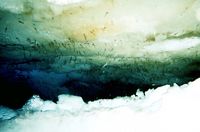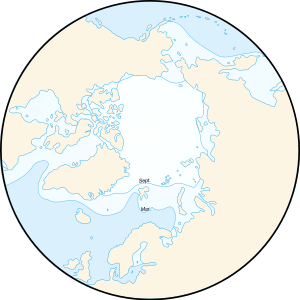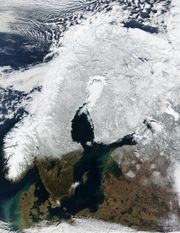Sea ice
2008/9 Schools Wikipedia Selection. Related subjects: Climate and the Weather
Sea ice is formed from ocean water that freezes. Because the oceans consist of saltwater, this occurs at about -1.8 ° C (28.8 ° F).
Sea ice may be contrasted with icebergs, which are chunks of ice shelves or glaciers that calve into the ocean. Icebergs are compacted snow and hence fresh water.
Types of sea ice
Land-fast ice or simply fast ice is sea ice that has frozen along coasts ("fastened" to them) or to the sea floor over shallow parts of the continental shelf, and extends out from land into sea. Unlike drift ice (see below), it does not move with currents and wind.
Drift ice consists of ice that float on the surface of the water, as distinguished from the fast ice, attached to coasts. When packed together in large masses, drift ice is called pack ice. Pack ice may be either freely floating or blocked by fast ice while drifting past.
The most important areas of pack ice are the polar ice packs formed from seawater in the Earth's polar regions: the Arctic ice pack of the Arctic Ocean and the Antarctic ice pack of the Southern Ocean. Polar packs significantly change their size during seasonal changes of the year. Because of vast amounts of water added to or removed from the oceans and atmosphere, the behaviour of polar ice packs have a significant impact of the global changes in climate, see " Polar ice packs" for details.
An ice floe is a floating chunk of sea ice that is less than 10 kilometers (six miles) in its greatest dimension. Wider chunks of ice are called ice fields.
Formation of sea ice
Only the top layer of water needs to cool to the freezing point. Convection of the surface layer involves the top 100–150 m, down to the pycnocline of increased density.
- In calm water, the first sea ice to form on the surface is a skim of separate crystals which initially are in the form of tiny discs, floating flat on the surface and of diameter less than 2-3 mm. Each disc has its c-axis vertical and grows outwards laterally. At a certain point such a disc shape becomes unstable, and the growing isolated crystals take on a hexagonal, stellar form, with long fragile arms stretching out over the surface. These crystals also have their c-axis vertical. The dendritic arms are very fragile, and soon break off, leaving a mixture of discs and arm fragments. With any kind of turbulence in the water, these fragments break up further into random-shaped small crystals which form a suspension of increasing density in the surface water, an ice type called frazil or grease ice. In quiet conditions the frazil crystals soon freeze together to form a continuous thin sheet of young ice; in its early stages, when it is still transparent, it is called nilas. When only a few centimetres thick this is transparent (dark nilas) but as the ice grows thicker the nilas takes on a grey and finally a white appearance. Once nilas has formed, a quite different growth process occurs, in which water molecules freeze on to the bottom of the existing ice sheet, a process called congelation growth. This growth process yields first-year ice, which in a single season may reach a thickness of 1.5–2 m.
- In rough water, fresh sea ice is formed by the cooling of the ocean as heat is lost into the atmosphere. The uppermost layer of the ocean is supercooled to slightly below the freezing point, at which time tiny ice platelets, known as frazil ice, form. As more frazil ice forms, the ice forms a mushy surface layer, known as grease ice. Frazil ice formation may also be started by snowfall, rather than supercooling.
Slush is a floating mass formed initially from snow and water. Shuga is fomed in agitated contidions by accumuation of slush or grease ice into spongy pieces several inches in sise.
Waves and wind then act to compress these ice particles into larger plates, of several metres in diameter, called pancake ice. These float on the ocean surface, and collide with one another, forming upturned edges. In time, the pancake ice plates may themselves be rafted over one another or frozen together into a more solid ice cover, known as consolidated ice pancake ice. Such ice has a very rough appearance on top and bottom.
The sea ice is largely fresh, since the ocean salt is expelled from the forming and consolidating ice by a process called brine rejection. The resulting highly saline (and hence dense) water is an important influence on the ocean overturning circulation.
Ecology

Sea ice is part of the Earth's biosphere. Solid sea ice is permeated with channels filled with salty brine. These briny channels and the sea ice itself have its ecology, referred to as "sympagic ecology".
The decline of seasonal sea ice is putting the survival of Arctic species such as ringed seals and polar bears at risk.


